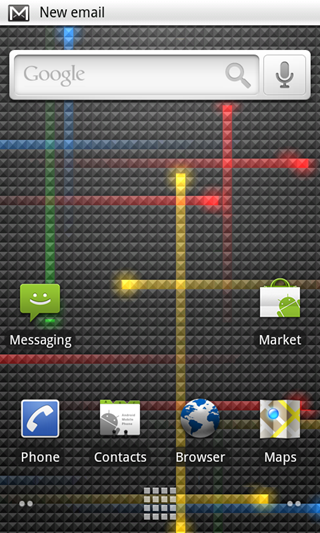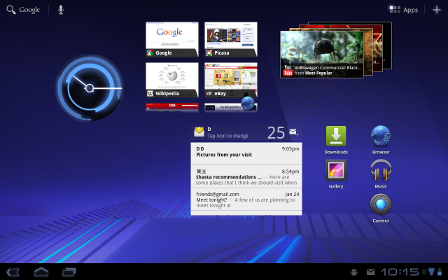Android 1.6: Donut
 |
| Android Donut/Gizmodo |
As you can see, Android came from humble beginnings. Donut came with a unified search framework that allowed you to search for everything from browser bookmarks and history, to contacts, the rest of the internet, and more. It also allowed for wallpapers, a few gestures(drawing letters to open certain apps or call certain people)
 |
| Donut Gestures/CNET |
and an update to the Play store. Which separated apps by games, apps, and general downloads. It also allowed developers to leave screenshots of their apps, and for users to leave reviews.
 |
| Android Market/Android Developers |
 |
| HTC Dream/GMS arena |
It packed a Qualcomm MSM7201A chipset with 192 mb of ram. Yeah that's right, MEGABYTES. The Dream was certainly not one by today's standards, heck it could even be considered a nightmare. But back around it's release, it helped bring Android into the mainstream. For that, us geeks should be ever greatful.
Donut was really the first commercial release of Android. In addition to what I mentioned previously, it also brought camera and camcorder support to Android. An obvious need in the mobile landscape of today and back then. It also featured a multi-lingual text-to-speech engine, which was really awesome for the visually impaired. All in all, Donut isn't great based on what we have today. But without the changes it brought we may never have seen Android flourish as much as it has.
Android 2.0: Eclair + Froyo
 |
| Android Eclair/Android Police |
Android Eclair wasn't a giant step forward for Android, but it certainly brought things forward somewhat. For one, visuals were much, much better looking. All those ugly icons that looked like they were out of UI's from years past were done away with. With some much cleaner looking additions. Eclair also brought Android live wallpapers, which some of its competitors still don't have to this day.
 |
| Android Froyo/Android Police |
I would talk about Android Froyo but it wasn't much of a change from Eclair. All that really changed was some serious performance improvements. So while it was a big deal, it wasn't really big enough to have its own section.
Android 2.3: Gingerbread
Android Gingerbread wasn't really much about visual improvements, but it did bring some serious performance improvements to Android. Especially in the gamin department, where new sensors allowed android games to do new things. Case in point, Teeter.
A game that allowed you to tilt and move your phone in order to avoid holes in a maze. While it was simple, at the time it was pretty cool; and I remember spending quite a bit of time messing around with it on our old Droid Incredible.
Gingerbread also brought NFC(Near-Field Communications) to Android. This allowed it to do things like read NFC tags, and later on transfer data through things like Android Beam. It was, and still is, something that hasn't been completely implemented by Android's biggest competitor, although they're getting there......
Android 3.0: Honeycomb
Honeycomb was well.... Not the best evolution of Android. It did bring really good tablet support, but it was kinda weird for a few reasons. For one, it's design language was something new to Android completely, and something we would never see again. It also didn't really help Android break into the tablet space, as though the UI was built for tablets. The apps and other multi-media content weren't really there. Apps weren't all optimized for tablets yet, so a lot of things just looked odd. We salute you Honeycomb for the good effort. But it wasn't still a little later we really saw Android tablets take off.
Android 4.0: Ice Cream Sandwich
Oh Android Lollipop.....from your beautiful animations to your lovely transitions, you've captured my heart. Every part of Android Lollipop was obviously crafted with love from Google. To the little bubbles you get when you tap on something
to the simplistic (but still beautiful) notification bar
To the little animation you get when you open the App Drawer(or pretty much anything else)
Android Gingerbread wasn't really much about visual improvements, but it did bring some serious performance improvements to Android. Especially in the gamin department, where new sensors allowed android games to do new things. Case in point, Teeter.
A game that allowed you to tilt and move your phone in order to avoid holes in a maze. While it was simple, at the time it was pretty cool; and I remember spending quite a bit of time messing around with it on our old Droid Incredible.
Gingerbread also brought NFC(Near-Field Communications) to Android. This allowed it to do things like read NFC tags, and later on transfer data through things like Android Beam. It was, and still is, something that hasn't been completely implemented by Android's biggest competitor, although they're getting there......
Android 3.0: Honeycomb
 |
| Android Honeycomb/Android Developers |
Honeycomb was well.... Not the best evolution of Android. It did bring really good tablet support, but it was kinda weird for a few reasons. For one, it's design language was something new to Android completely, and something we would never see again. It also didn't really help Android break into the tablet space, as though the UI was built for tablets. The apps and other multi-media content weren't really there. Apps weren't all optimized for tablets yet, so a lot of things just looked odd. We salute you Honeycomb for the good effort. But it wasn't still a little later we really saw Android tablets take off.
Android 4.0: Ice Cream Sandwich
 |
| Android Ice Cream Sandwich/Android Developers
Ice Cream Sandwich, in my opinion, was the version of Android where it finally grew up. Let me explain, before Android 4.0, Android's design wasn't great, it still wasn't that smooth, and the Play Store was still sort of in its infancy. But with this tasty cold treat, came better multitasking, overhauled design, better looking app drawer, and much,much more. I couldn't really go into detail for the amount of stuff ICS brought to Android, but I can tell you it was a massive step forward that really cemented Androids place as a mature mobile operating system.
Android 5.0: Lollipop
|
Oh Android Lollipop.....from your beautiful animations to your lovely transitions, you've captured my heart. Every part of Android Lollipop was obviously crafted with love from Google. To the little bubbles you get when you tap on something
to the simplistic (but still beautiful) notification bar
To the little animation you get when you open the App Drawer(or pretty much anything else)
There was obviously a lot of care put into Android Lollipop. Not a whole lot has changed under the hood, other than the change from ART to Dalvik and a few other things. They're a big deal, but to most users they probably won't make a huge difference. Android Lollipop was meant to be more for visual and cosmetic changes, to bring Android into the future, and to allow Android to become more unified under material design. It has accomplished just that, and I'm excited to see just how far it goes from here. Well done Matias Duarte, well done......
What's your favorite flavor of Android? Let me know on twitter @masala_tech, and remember to keep things spicy!
By Sahen Rai










